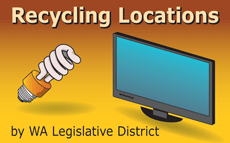
Packaging
The Problem: Volume, Waste, Cost, Design
Manufactured products and their associated packaging[1] make up 75% of the waste generated in the United States each year, yet less than half of this material is being recycled.
Volume: In Washington, over 2.3 million tons of packaging and printed paper are generated in the state each year. Of this total, 1.1 million tons are discarded each year and 1.3 million tons (54%) are recycled. The percentage of materials recycled has plateaued despite the fact that curbside recycling programs have expanded and are now available to 80% of Washington residents and drop-off recycling is available to the other 20%.
Waste: 95 million tons of packaging and printed paper are generated per year in the U.S. and only 49 million tons (52%) are recycled. This represents over 45 million tons of wasted packaging resources each and every year. Recycling these materials at levels currently being achieved in Canada and Europe would create an additional 2,000 jobs, reduce GHG emissions by 467,000 metric tons of carbon equivalent (a reduction equal to removing 314,000 passenger cars from the road each year) and generate an additional $48 million of commodity value to Washington residents, recycling businesses, waste management companies, and municipalities. In turn, this additional tonnage would be available for use as feedstock in manufacturing processes, reducing reliance on valuable natural resources.
Cost: Wasted packaging and paper end up in landfills and incinerators or are littered on beaches, playgrounds, country roads, and city streets. The costs to state and local governments for disposal, recycling, and litter cleanup adds up to millions of dollars a year, dollars that could be spent on other programs.
Design: Packaging materials can be designed and manufactured from many types of materials including “multi-material” packaging that combines paper and metal in one package and “biodegradable” packaging that may or may not be compostable in commercial compost facilities. Many material recycling facilities (MRF’s) have difficulty separating recyclable from non-recyclable materials. As a result, loads containing non-recyclable materials may become “contaminated” resulting in a lower material value or reducing the recyclability of the materials.
Product Stewardship Solutions
Manufacturers, retailers, and others can work together to reduce the amount of wasted packaging and printed paper.
Take Back: The ten states with container deposits are recycling more bottles and cans than the other 40 states combined and account for over 90% of the container recycling that occurs. Glass and other materials collected through deposit systems, unlike those collected through curbside recycling, are of a higher quality, and are thus more marketable. The amount of the deposit also has an impact on the recovery rate. Michigan, the only state with a 10 cent deposit, also has the highest recovery rate at 95%.
Legislation: In Europe and Canada, a product stewardship approach to packaging and printed paper has resulted in recycling rates that average more than 65%, with recycling rates for some materials much higher. These programs vary in structure and operation but share the following:
- Producers (also known as brandowners) of packaging materials share in the cost of residential recycling collection programs.
- Producers have the option of joining together to pool resources and administer their financial obligations.
- Producers pay into the pool based on the quantity and type of packaging materials they use.
- Producer organizations report annually to the government oversight agency.
- Producers contract with the private sector or with local government to provide collection services.
In Europe, recycling goals have been established by the European Union, and in Canada these goals are set by the individual provinces. For the most part, these recycling goals have been achieved on schedule. Given all of these considerations, a product stewardship approach offers a promising opportunity to boost recycling rates significantly without additional costs to local governments while keeping much of the current recycling infrastructure intact.
Design: Manufacturers can address some existing challenges, such as multi-material packaging that includes paper and metal in one package, or newer “biodegradable” packaging that may or may not be compostable in modern commercial-scale compost facilities, by designing products with end of life management in mind.
Read the Council’s report Analyzing Product Stewardship Policies for Packaging and Printed Paper in Washington State (PDF, March 2011) for source material and further information.
[1] Packaging materials are used for the containment, protection, handling, delivery and presentation of goods. The most common packaging materials are cardboard, aluminum cans, tinned steel cans, PET LDPE and HDPE plastics, and glass. With the exception of glass and LDPE, all of these materials are commonly collected in residential curbside recycling programs.
Printed paper includes newspaper, magazines, third-class mail and paper generated by households and businesses from home- or office- based equipment such as printers, scanners, fax machines and copiers.
